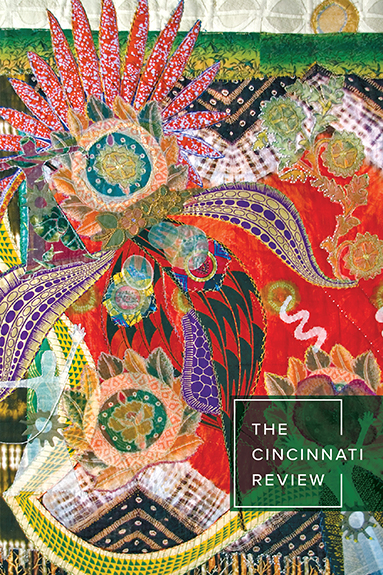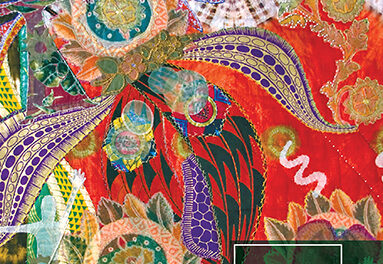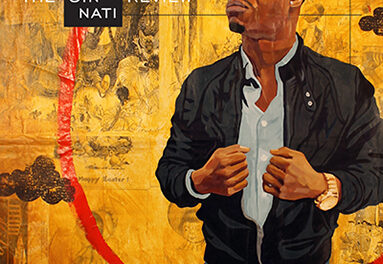In Issue 20.1, we present a craft review feature celebrating the art of extraordinary writing. The feature was inspired by Holly Goddard Jones’s “Unreasonably Good Stories: Breaking the Competency Ceiling,” and we’re pleased to share here Rachael Uwada Clifford’s contribution to the conversation. (Read the entire feature here.)
The Unpassing. Chia-Chia Lin. Farrar, Straus and Giroux, 2019. 288 pp. $26.00 (cloth).
The June after I turned fifteen, my family moved to New Mexico. We drove twenty hours away from a small Georgia town in quiet decline where we had lived for eleven years. I remember the early days of that Georgia house, old and full of holes and hiding places, so well. How anxiously the animals—rats, mostly—tried to get in, and did get in, from the yard and the woods. How we’d boil water for baths, the pipes faulty. And how my brother and I, exploring the house’s nooks and crannies, would find the small toys of the children who had lived there before us. How strange those children seemed in their absence. Soon my father patched and sealed and stuffed everything up. Eventually, after an electrical fire, the house got a complete-gut renovation and almost became a different house altogether. Leaving was difficult. Driving through Alabama and Mississippi felt familiar enough, but I remember a certain shift in the air somewhere between Oklahoma and Texas. By the time we reached New Mexico, it could have been another earth. The land and sky widened. The air thinned. That night the moon was low and full. It skimmed along the horizon, at the bottom of the mountains, as we drove; I didn’t know moons could do that.
All this to say, I am perhaps unusually predisposed to liking novels involving US states with strange landscapes; houses where the delineation between inside and outside is not always so clear; children who are ghost or gone, or both; and optimistic immigrant fathers who like a good DIY project (or three). Chia-Chia Lin’s first novel, The Unpassing,offers all of this and more still. Set in the 1980s, on the mostly wild edges of Anchorage, Alaska, it tells the story of a grieving Taiwanese immigrant family from the perspective of a now-adult son, Gavin, reflecting on his childhood. Grief, migration, and the myth of America are of course well-worn literary themes, and what sets this novel apart from others like it is the stark, startling sense of place Lin evokes on every page. With her portrait of a setting equal parts brutal and beautiful, she elegantly convinces us that this novel could not have taken place anywhere but Alaska.
In her 1956 essay “Place in Fiction,” Eudora Welty writes, “The truth is, fiction depends for its life on place. Location is the crossroads of circumstance, the proving ground of ‘What happened? Who’s here? Who’s coming?’—and that is the heart’s field.” For both Welty and me, place in fiction offers all manner of questions in which the heart is especially invested. This is why, I think, for a novel to be unreasonably good, it must do all it can to resplendently establish place. I believe the best novels make the reader feel, and place is the most immediate path to feeling. When I conjure the sensations of my childhood home—the singing screech of the ancient tea kettle, the mothball smell of my father’s closet, the thwack of beetles hitting our windows on summer nights—I am flooded with feeling: safety and solitude, levity and lonesomeness. In The Unpassing, Lin illuminates how the constitutive elements of place—sight, sound, taste, touch, smell—can transcend themselves to produce the rich realm of feeling.
Passage after passage exquisitely embodies a sense of place at once external and internal to the characters. At one point, forced to leave their home, Gavin and his family venture to the Kenai Peninsula, where a classmate’s family vacations and where the summers—unlike in Gavin’s hometown—are actually hot. On the drive there, Gavin wonders at the transition of climates: “We had driven south along the inlet before, but only up to the ghost forests. The coastline there had sunk during the Good Friday earthquake, and the spruce forests had guzzled salt water and died. Decades later, the silvery skeletons of those trees still stood, petrified by salt and leaning drunkenly, some nearly horizontal. It might be there, in the bewitched space where trees defied time and gravity, that the world shifted.” This is place in its barest concrete sense—the sunken coast, the salt, the spruces. But this is also place in the sense of the narrator’s internal landscape—place that constitutes the narrator’s very being and helps him articulate his feelings and questions. Here Gavin is not only talking about the transition between cold weather and hot weather. He is also drawing our attention to—while attempting to make sense of—the other kinds of transitions that happen in the novel: the transitions between life and death, between familiar and strange. This fluidity of feedback between internal and external states is part of how place becomes character in The Unpassing.
Lin’s skillful rendering of place as character also emerges in the way that certain settings in the novel quite literally take on lives of their own. In the best novels, place is more film sequence than landscape painting, ever changing and churning—at times physically, at times metaphysically. Lin captures this dynamism most evocatively through her depiction of the forest surrounding the family’s home, a familiar forest that can become unfamiliar at will. Stumbling through the dark woods in search of his younger brother, Gavin notes: “The trees took up more space at night; their shadows added to their volume.” Far from static backdrop, here the natural world is unpredictable, heightening fears or offering healing and liberation, depending on time of day, on season, on whim. In a different scene, playing after school with a classmate who is brave enough to walk in the woods alone, Gavin—self-conscious about his own fear—works to rationalize it: “It seemed to me the woods wanted something of us. And the farther you went into the woods, the bigger that thing was, and the more intensely it was wanted.” Lin’s hand is especially deft here; she might have simply written that Gavin felt afraid or anxious in the deep woods. But she opts for a more expansive inversion: rather than directly describing Gavin’s interiority in the woods, she instead attends to Gavin’s imagination of the interiority of the woods. Implicit in this imagination, of course, is Gavin’s own interiority, but the way the reader arrives at it is through place—through the surprise of place as a being that can also want, and through a much fuller and more immediate sensorial experience than we’d have had absent Lin’s inversion.
The dynamism of Lin’s place-making does two other important things for the novel. First, within the context of a narrative where interiority is so bound up with exteriority, and where the main characters are working-class immigrants of color, a rendering of place that lacked dimension or complexity or contradiction would in turn deprive the characters of those same qualities. Vitally here, and in large part a result of Lin’s mastery of place, the characters feel fully and wonderfully realized. Second, Lin’s dynamic place-making allows for necessary moments of rupture in the book. Never does Lin bear too heavily down on the severity of the landscape or of the characters’ impoverished conditions in it; there are bursts of surprise, of wonder, of ease. The family truck careens into a late-blooming patch of daylilies; the mother climbs out, collects the buds, and makes soup. At the first sight of spring sun the children play ecstatically in a clearing. The forest opens into a friend’s sun-filled backyard, “a lovely shock, a rich apricot pool where the late afternoon light gathered and stewed.” For the color palette of The Unpassing, Lin relies primarily upon blacks and blues, grays and greens, but moments like these indeed serve as “lovely shocks.”
Lin is as interested in the built world as she is in the natural world—and especially, it seems, in the frequently murky division between the two. If there were an award for most compelling literary houses, the house in The Unpassing would be a solid contender. Surrounded by a half-wilderness, it remains the lone home in an unfinished subdivision: “‘When the others move in,’ my father used to say, followed by his own vague wishes: the road might be paved, the mailbox might be relocated, the wind might not blow so hard on us. At some point the future ossified, our ghost neighbors vacated, and he talked in should-haves.” And the house itself does not simply have character; it too isa character, living and breathing—figuratively and literally: “Mushrooms sprouted in our bathroom with the seasons, tracking time. They grew from the seam between the floor and wall, and the caps were perfect and unblemished, curving over their stems like modest skirts.” The image—if one can call this simply an image—is both horrifying and fascinating. The house is perpetually damp. The characters bring rain and snow in—and other materials from nature find their way past the door too. Frustrated by skittering sounds at night, the father breaks open the sealed attic, and out tumbles a heap of spruce cones and squirrel skeletons. Before this discovery, the eldest daughter, Pei-Pei, had insisted there were children in the attic—“paler, thinner versions of us who played in constant darkness.” While there are several deaths in this novel, and while the characters are haunted—and, at times, haunt—this is not a ghost story.
But Pei-Pei’s invention of the ghost children illustrates something the novel does so wondrously throughout, with its place-making: It engages all of our senses—including our sixth. Some unnamed thing hovers just over every scene of The Unpassing, something we get wind of only through the attentiveness Lin pays to the air itself—again, literally and figuratively. This scene, where the mother is simmering beef bones for broth, perhaps best illustrates the latter sense: “‘The soft marrow. We’ll cook them until they crumble, until they release their animal souls.’ When she went on like this, talking to someone we didn’t know, the air felt thinner in the room.” These unsettling moments work particularly well because they are always anchored to some sensorily rich, concrete detail—the marrow bones, in this case. Lin’s use of the sixth sense becomes, for me, such a lucently evocative way of drawing attention to the characters’ past and possible lives in Taiwan. These lost selves in fact seem to haunt the characters more than any of the actual lost loved ones in the novel. Which is part of what gives The Unpassing its miraculous pulse: It’s not about the dead at all. It’s about the living. At one point, the family becomes homeless following an eviction, and they return to their abandoned house and begin to haunt it—or to create a life again, depending on how you look at it.
After finishing The Unpassing, I found myself wondering at how little the narrator actually speaks—but how well I felt I knew him. Perhaps this is the highest testament to what makes this novel, and its sense of place, unreasonably good. By way of Lin’s graceful collapsing of the lines between the built and natural, internal and external worlds, the novel’s expansive, expressive landscape never feels as though it is at odds with taciturn, too-small-for-his-age Gavin; instead they feel like each other’s natural counterparts, extensions of each other, ways into making sense of the other. Like Gavin, I was a quiet, observant child. Like Gavin, I carry certain houses and certain woods everywhere. And what I love most about Lin’s engagement with place, the space and attention she allocates to it, is how it becomes a kind of tending—to wild places, quiet children, and all the things that happen when they meet.
Rachael Uwada Clifford is a writer, poet, and PhD candidate at Princeton. Her writing appears in Glimmer Train and Best New Poets. She lives in Philadelphia, where she is at work on her first poetry collection and her first collection of short stories.











